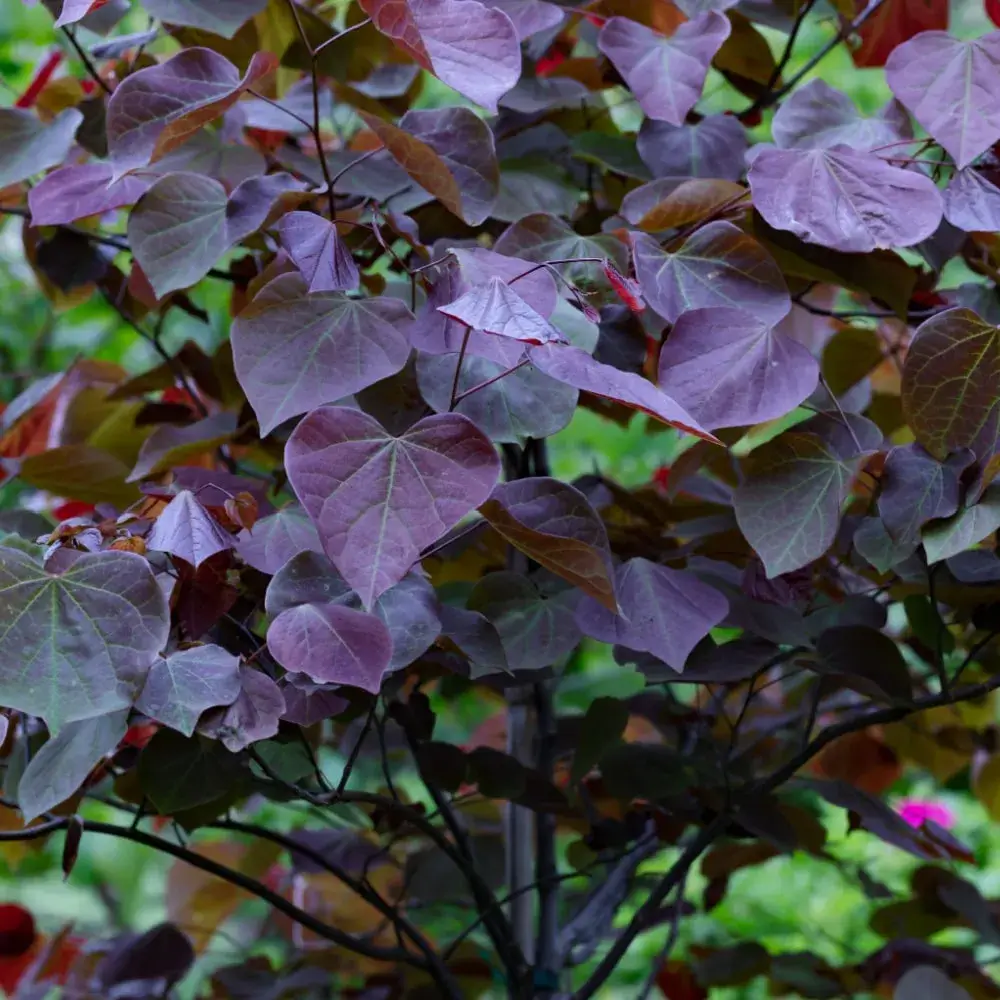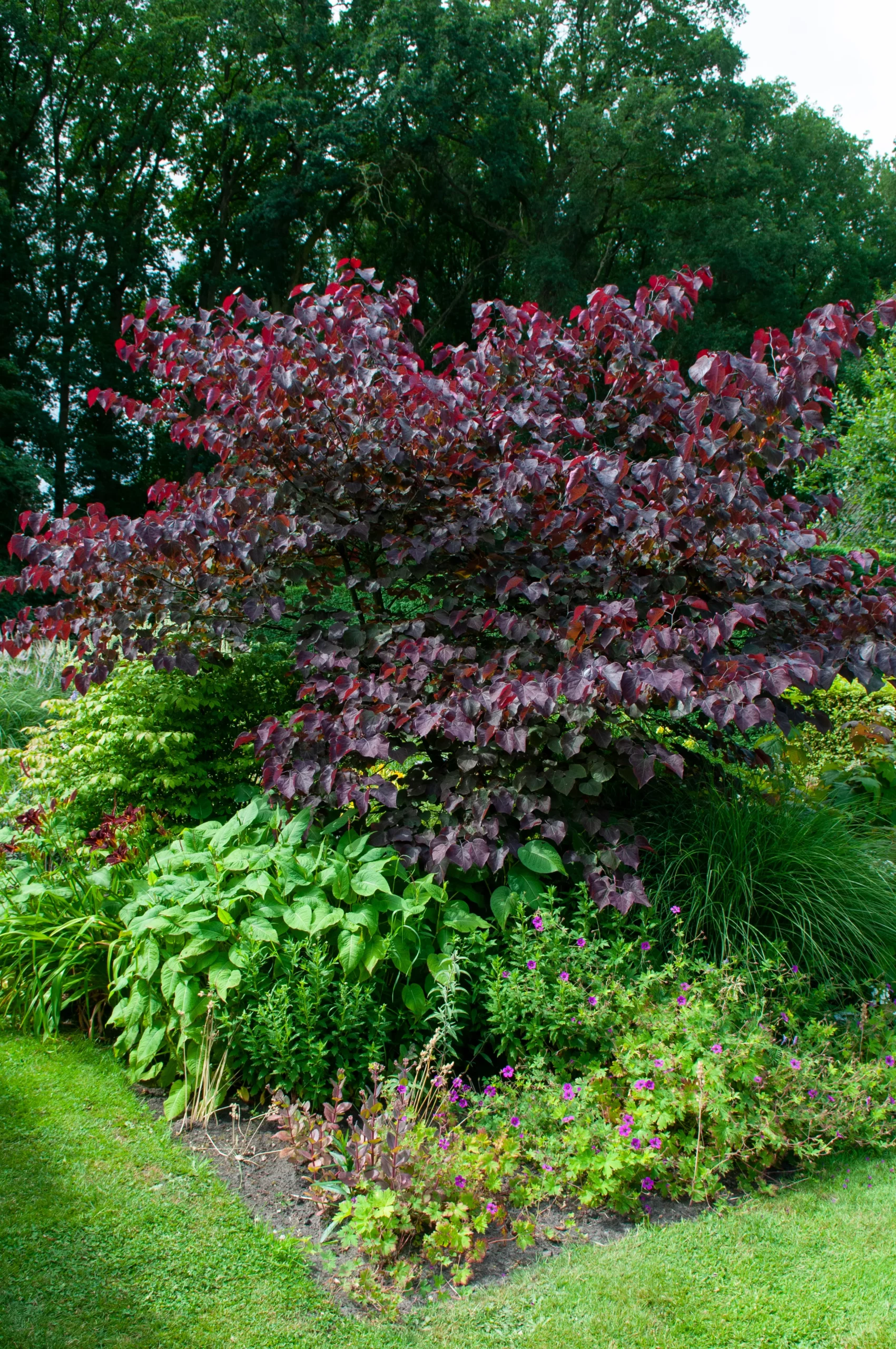Family: Redbud
Type: Tree
Other Common Name: Eastern Redbud, Judas Tree, Love Tree

The Forest Pansy Redbud is a striking ornamental tree, known for its vibrant purple leaves. It’s a variant of the Eastern Redbud, native to the eastern U.S.
This tree blooms with pink flowers in early spring, creating a breathtaking contrast with its dark foliage. It’s a medium-sized tree, ideal for residential gardens.
The Forest Pansy Redbud is not just a visual treat; it’s also low-maintenance. It thrives in a range of soil types and is drought-tolerant once established.
Hardiness Zone: 5a-6a
Deer Resistant: Yes
Pet Friendly: Yes
Moisture Preference: Average to moist
Sun Needs: Full sun to partial shade
Growth Rate: Medium
Average Height (feet): 25
Average Spread (feet): 30
Average Life Span (years): 60
Form: Round
Flower Color: Purple
Flower Shape: Pea
Bloom Season: From early to mid spring
Foliage Color: Red
Foliage Shape: Heart
Bark Color: Dark brown
Bark Texture: Rough
Integrating the Forest Pansy Redbud into your landscape adds a splash of color. Its unique foliage stands out among other greenery.
This tree works well as a focal point in your yard. Its size and shape make it suitable for small to medium spaces.
Consider pairing it with light-colored plants. The contrast enhances its deep purple leaves, creating a dramatic effect.

In a cottage garden, the Forest Pansy Redbud's informal growth and vibrant blooms fit perfectly. Its natural charm complements a relaxed, diverse planting style. The tree's color and form add depth and interest, harmonizing with perennials and shrubs common in cottage gardens.
In modern garden designs, the Forest Pansy Redbud adds a pop of color. Its bold foliage and architectural form suit minimalist landscapes. This tree becomes a statement piece, contrasting with sleek, geometric lines and monochromatic color schemes typical of modern gardens.
In a woodland garden, the Forest Pansy Redbud thrives. It naturally blends with a woodland setting, mirroring the understorey trees of its native habitat. Its spring blooms and colorful leaves enrich the layered, naturalistic design of a woodland garden.
Use the Forest Pansy Redbud as a natural privacy screen. Its dense foliage provides seclusion without overwhelming the space.
Create a seasonal interest corner in your garden. Plant the Redbud with other seasonally changing plants for year-round appeal.
Use it near water features. The reflection of its vibrant leaves in water adds an extra dimension of beauty.
Select our pre-made garden layouts to create a landscape that’s uniquely yours. Simple, smart, and customizable!
In spring, the Forest Pansy Redbud is a sight to behold. It bursts into a profusion of pink flowers, followed by purplish-red leaves. This colorful display heralds the arrival of warmer days, making it a garden centerpiece.
During summer, the tree's heart-shaped leaves mature to a deep burgundy. It offers a cooling, shady canopy. The Forest Pansy Redbud remains a focal point, even as other garden plants come into their prime.
In fall, the leaves of the Forest Pansy Redbud transform into shades of orange, red, and bronze. This seasonal change adds a warm, vibrant touch to the cooling landscape, complementing the autumn palette.
In winter, the Forest Pansy Redbud stands bare but elegant. Its intricate branch structure and overall shape offer visual interest. The tree's silhouette against the winter sky is a stark reminder of the dormant beauty of nature.
Choose a spot for your Forest Pansy Redbud where it can truly shine. An area with good air circulation and enough space for its mature size is ideal. Avoid planting too close to buildings or power lines.
Forest Pansy Redbuds prefer full sun to partial shade. A spot that receives at least six hours of sunlight daily is optimal for vibrant foliage color and abundant flowering.
Well-drained soil is crucial for the health of your Forest Pansy Redbud. It tolerates a variety of soil types, from acidic to slightly alkaline, as long as the drainage is good.
Allow about 20 to 30 feet of space around the tree. This spacing accommodates its mature canopy and root system, ensuring healthy growth and development.
The best time to plant a Forest Pansy Redbud is in early spring or fall. Cooler temperatures and more moisture at these times support root establishment.
Dig a hole twice as wide as the root ball and as deep. Ensure the tree is planted at the same depth it was in its container. Backfill with soil and water thoroughly.
Regular watering is vital, especially during the first growing season. Once established, the tree is somewhat drought tolerant but benefits from occasional deep watering.
Apply a balanced, slow-release fertilizer in early spring. This supports healthy growth and flowering but avoid over-fertilizing.
Prune in late winter or early spring to remove dead or crossing branches. This maintains the tree’s shape and health.
In spring, monitor soil moisture and water as needed. Apply mulch to retain moisture and control weeds, and fertilize to support new growth.
During summer, maintain consistent watering, especially in dry periods. Check for pests and diseases, treating as necessary to keep the tree healthy.
Reduce watering in fall as the tree prepares for dormancy. Clear away fallen leaves to prevent fungal diseases and apply a light layer of mulch for winter protection.
In winter, minimize watering. Protect the tree's root zone with mulch, and avoid mechanical damage from snow removal or de-icing salts.
The Forest Pansy Redbud is a moderately fast-growing tree. It can grow 1 to 2 feet per year, reaching its full size in about 20 years.
Yes, it’s hardy in USDA zones 5 through 9. It can withstand cold winters but may need extra protection in the northern parts of its range.
No, the Forest Pansy Redbud is not known to be toxic to pets. It’s a safe choice for gardens where pets are present.
Sign up below to get exclusive deals, discounts, and new plant collections—delivered straight to your inbox! Plus, stay inspired with the latest gardening tips, landscaping trends, and DIY garden ideas. Start growing with us today!
A big thank you for subscribing to the PBN Design newsletter.
We're thrilled to have you join our community. Get ready for exciting updates, insightful content, and more delivered straight to your inbox.
Stay tuned!
Go backA big thank you for subscribing to the PBN Design newsletter.
We're thrilled to have you join our community. Get ready for exciting updates, insightful content, and more delivered straight to your inbox.
Stay tuned!
Go back